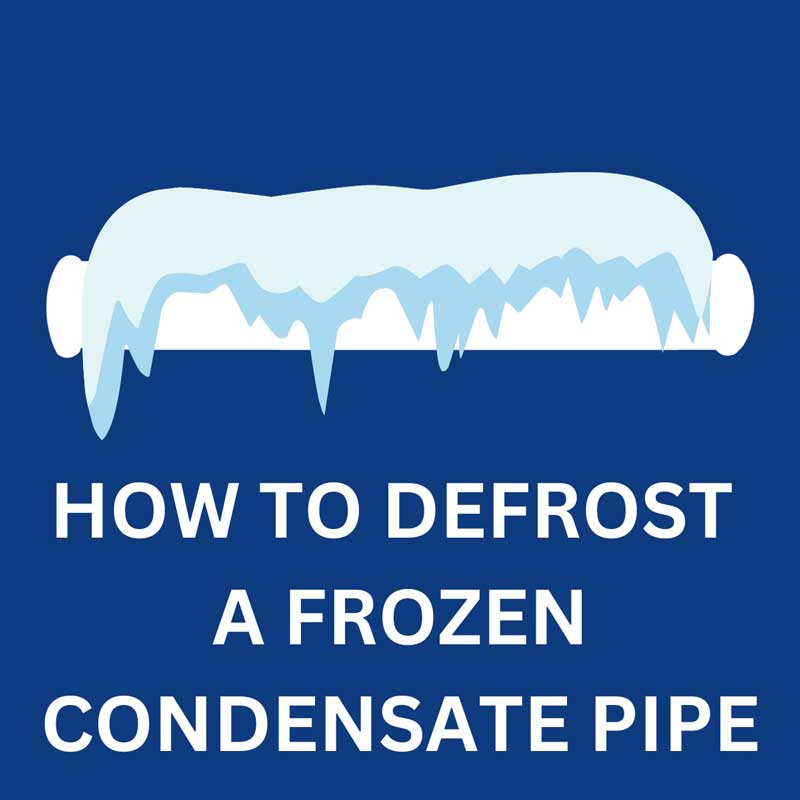
A frozen Condensate pipe will prevent your Boiler from working, depriving you and your family of heating and hot water.
Fortunately, frozen condensate pipes can be defrosted swiftly; this article will explain how.
What Is A Condensate Pipe?
A condensate pipe transports the acidic water, a byproduct of combustion in condensing boilers, away from the Boiler and safely disposes it into the drain.
While these systems are highly efficient and eco-friendly, they come with a vulnerability—particularly during winter.
This vulnerability is the freezing of the condensate pipe. A frozen condensate pipe will cause the Boiler to stop, leaving you without heating or hot water during the very weather conditions when they’re most needed.
Why A Frozen Condensate Pipe Stops A Boiler From Working
When the condensate pipe freezes, it can cause a series of issues that cause the Boiler to stop. Here’s why:
Blockage Due To Ice Formation
When the condensate pipe freezes, the ice creates a blockage, preventing the condensate water from being expelled from the Boiler. This accumulated water has nowhere to go, creating a backlog.
Safety Mechanisms Activate
Modern Boilers have safety mechanisms that detect when the condensate pipe is blocked. These mechanisms will shut down the Boiler to prevent any damage or flooding. This shutdown is protective, ensuring the accumulating condensate does not cause internal damage or overflow.
Potential for Damage
If the safety mechanisms fail or the Boiler continues to operate with a frozen pipe, the backed-up condensate can lead to water damage. This is especially true when the ice eventually thaws, potentially causing a leak or even a burst pipe due to the pressure buildup.
Acidic Nature of Condensate
The condensate water is slightly acidic, a result of the combustion process. If this water doesn’t drain away correctly and starts to accumulate, it can lead to corrosion or damage to the Boiler’s internal components over time.
Increased Pressure
A blocked condensate pipe causes increased pressure within the Boiler. Modern boilers often have pressure sensors that detect this abnormality, leading to the Boiler entering a fault or safety mode.
Identifying A Frozen Condensate Pipe
It’s important to confirm that the pipe is indeed frozen. If there are freezing conditions outside and the Boiler stops, won’t start, or starts and stops shortly after, then it’s highly likely the condensate pipe is frozen.
Modern boilers often display a fault code to indicate a problem with the condensate pipe.
A more direct way to diagnose the issue is by visually inspecting the condensate pipe, the section that runs outside the house. If you see ice formations on the pipe or frosty patches, it indicates that the pipe has frozen.
Safety First
Safety should always be your priority when addressing a frozen pipe:
- Shut Down the Boiler: Before any attempts to defrost, always ensure the Boiler is turned off to prevent unforeseen complications.
- Stable Footing: Ensure that the area around the pipe is dry. If you work outside, be wary of icy patches to avoid slips and falls.
- No Open Flames: Using a direct flame to speed up the thawing process might seem tempting, but this is risky. The sudden temperature change can damage the pipe, the flame could melt the plastic pipe, and open flames come with fire risks.
Methods To Defrost The Condensate Pipe
Defrosting the condensate pipe can be achieved using household items. Here are some effective methods:
Warm Cloth Or Towel
Soak a cloth or towel in warm water (not boiling). Wring out the excess water and then wrap it around the frozen section of the pipe. This gentle heat will help melt the ice within. Refresh the towel as needed.
Hot Water Bottle
This method involves placing a hot water bottle or a heat pack on the frozen section. The heat will gradually transfer to the pipe, aiding the defrosting process. Ensure the bottle remains in place by securing it if necessary.
Hair Dryer
A hair dryer, set to a low or medium setting, can be a handy tool. Move it slowly along the frozen section, ensuring you don’t overheat any part of the pipe or melt any nearby plastic fixtures.
Portable Heater
If you have a portable electric heater, you can position it to blow warm air onto the frozen section. This method is especially useful for pipes that are harder to reach. Always follow safety guidelines when using heaters, and keep them away from wet areas.
Once the water inside the pipe has thawed, switch your Boiler back on.
Preventative Measures for the Future
Prevention is always better than cure. The most effective preventive measure is insulating the pipe. Use suitable lagging, especially on pipe sections exposed to the cold outdoors.
When to Call a Professional
Sometimes, DIY fixes might not be enough. It’s essential to know when to call in the professionals:
- If, after thawing the pipe, you notice cracks or damages, it’s best to seek professional assistance for repair or replacement.
- If you need more clarification about any step of the defrosting process, it’s always wiser to consult a heating engineer.
Need Help With Your Condensate Pipe?
Please get in touch with us if you live in the Essex area and require assistance with your Condensate Pipe. We can get you a Gas Safe Registered engineer the same day.
0% Finance
For Boiler Installations & Repair
